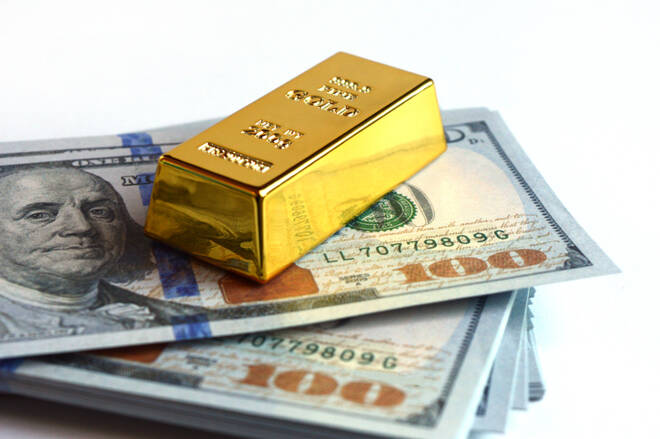Advertisement
Advertisement
Price of Gold Fundamental Daily Forecast – Supported as Recession Fears Outweigh Hot Inflation Reading
By:
The Personal Consumption Expenditures (PCE) price index rose 6.8% from a year ago in June, hitting its highest level since January 1982.
Gold futures rose to their highest level since July 6 on Friday as falling Treasury yields continued to drag down demand for the U.S. Dollar. The catalyst was increased bets the Federal Reserve may slow down the pace of rate hikes as economic risks deepen, following the release of Thursday’s weaker-than-expected U.S. Gross Domestic Product (GDP) report.
On Friday, December Comex gold futures settled at $1781.80, up $12.60 or +0.71%. The SPDR Gold Shares ETF (GLD) finished at $164.13, up $0.49 or +0.30%.
Despite the early rise, gold prices retreated off its intraday high and the U.S. Dollar rose from its intraday low on the back of another jump in U.S. inflation that could give the Federal Reserve more ammunition to aggressively hike rates.
Treasury Yields Retreat on US Recession Fears
U.S. government Treasury yields fell Friday as traders continued to weigh the prospects of a recession following a second consecutive quarter of economic contraction. The price action suggests investors are reducing their bets on an aggressive rate hike (75 basis points or more) by the Federal Reserve in September. Lower yields tend to be supportive for non-yielding gold.
US Dollar Hits Three-Week Low
The U.S. Dollar fell against a basket of major currencies Friday to its lowest level since July 5, as investor concerns about recession outweighed inflation worries, for now, amid a batch of economic data. A weaker greenback tends to support gold because it makes the dollar-denominated asset more attractive
US Economic Data Shows Red-Hot Inflation
On Thursday the Bureau of Economic Analysis reported that the Personal Consumption Expenditures (PCE) price index, an inflation indicator closely watched by the Fed, rose 6.8% from a year ago in June, hitting its highest level since January 1982. The PCE jumped 1.0% last month, the largest increase since September 2005 and followed a 0.6% gain in May. Excluding the volatile food and energy components, the PCE price index shot up 0.6% after climbing 0.3% in May.
In other economic news, U.S. consumers lowered their views of where inflation is headed in July, a closely watched survey showed on Friday, a downshift in expectations that will be welcome news at the Federal Reserve in its battle with the highest inflation rate in four decades.
Short-Term Outlook
Thursday’s U.S. Gross Domestic Product (GDP) showed a decline, but Friday’s PCE price index showed inflation rose from a year ago. This being said, we’re getting close to the classic definition of stagflation. However, we can’t say that yet because we still have relatively high employment. If the unemployment rate were rising then we could start talking about the evils of stagflation.
All this means is that next Friday’s U.S. Non-Farm Payrolls report could be a major market moving event.
I think the Fed cares about lowering inflation and isn’t too worried about a recession at this time, but it will take notice if payrolls drop or the unemployment rate rises.
As far as gold is concerned, all I’m seeing is short-covering and position-squaring and a little speculative buying. However, the Fed is still on course to raise rates, even if it’s “only” 50 basis points in September so I believe gold traders are still in “sell the rally” mode.
For a look at all of today’s economic events, check out our economic calendar.
About the Author
James Hyerczykauthor
James Hyerczyk is a U.S. based seasoned technical analyst and educator with over 40 years of experience in market analysis and trading, specializing in chart patterns and price movement. He is the author of two books on technical analysis and has a background in both futures and stock markets.
Advertisement
